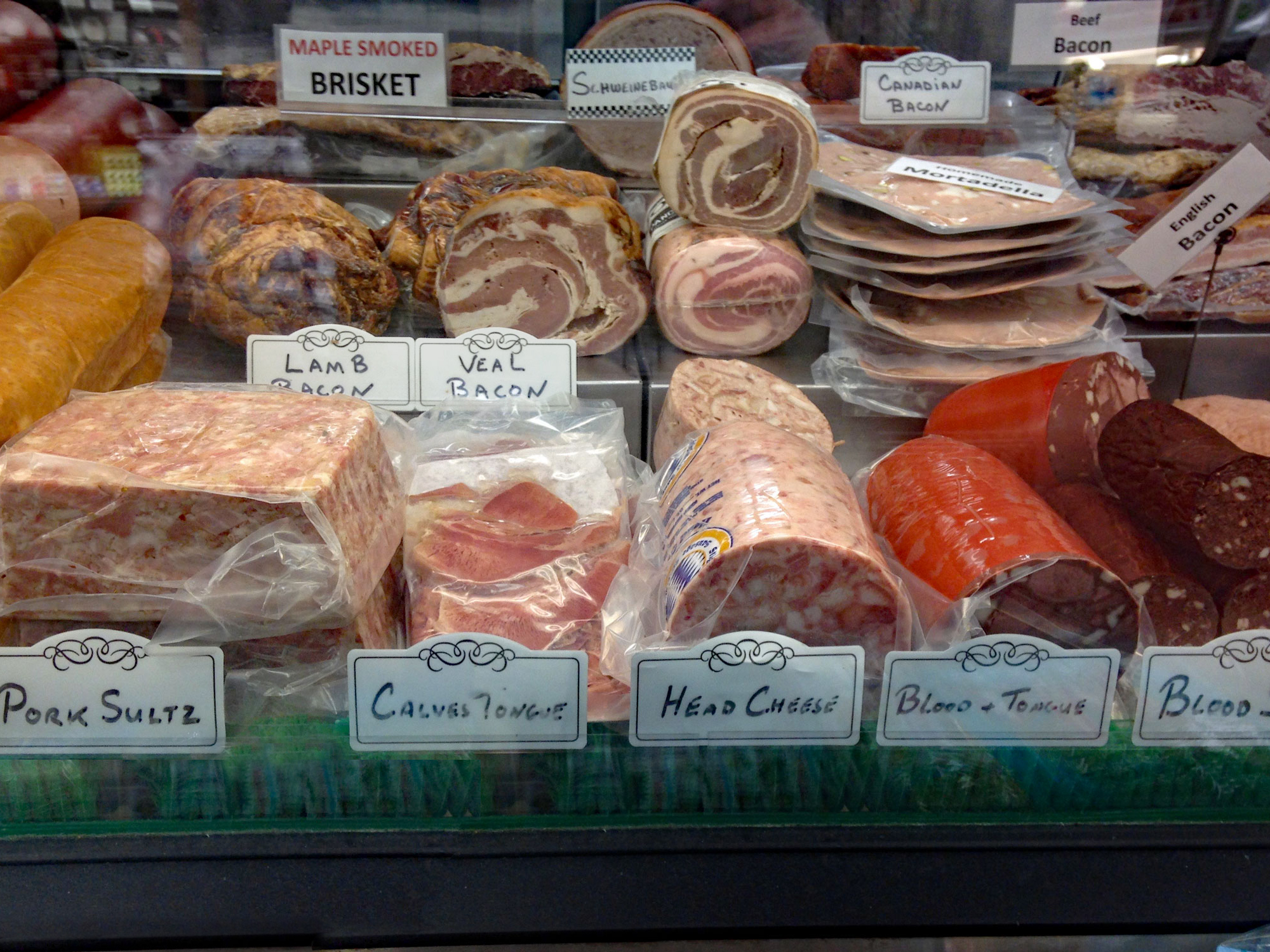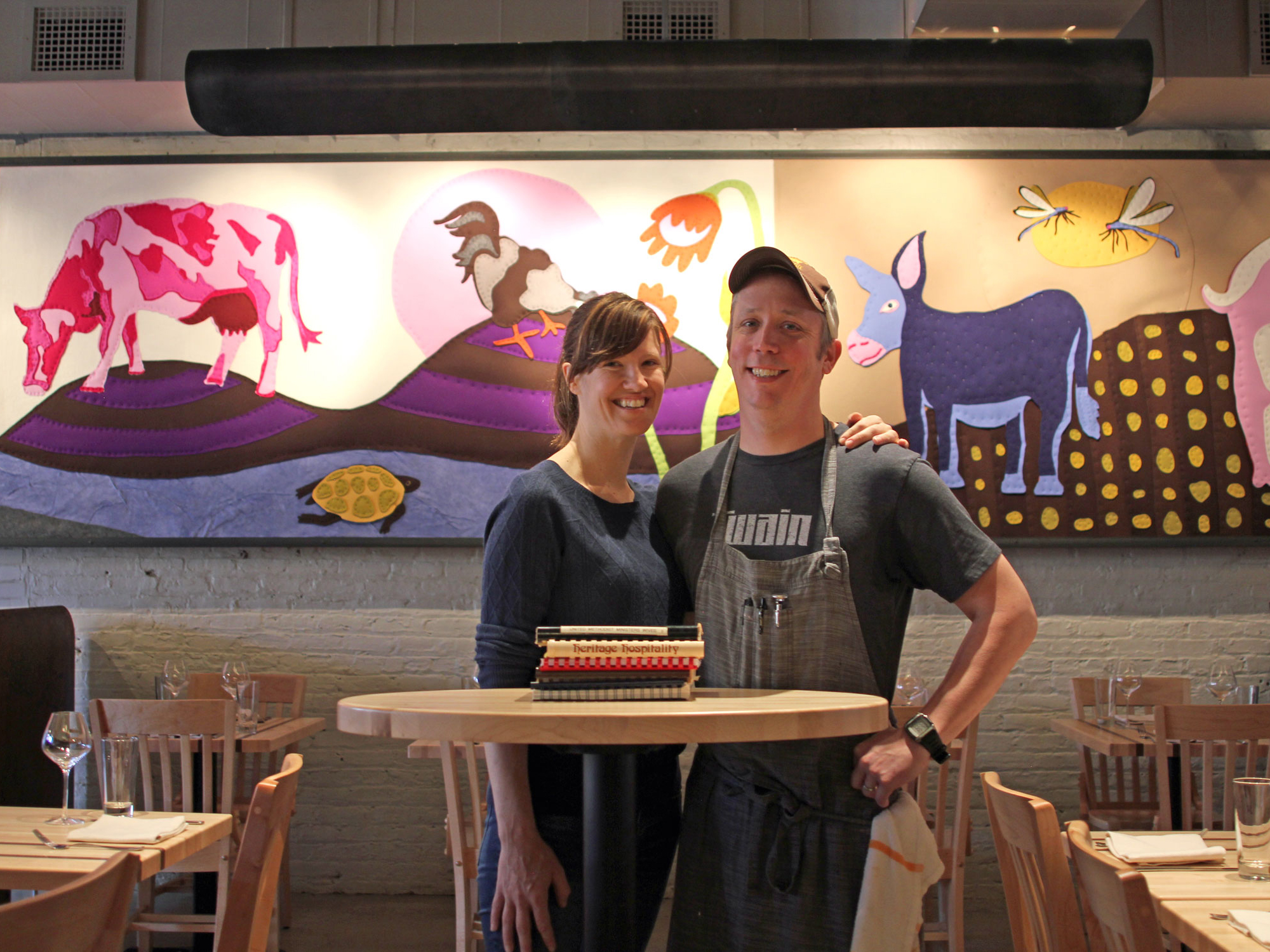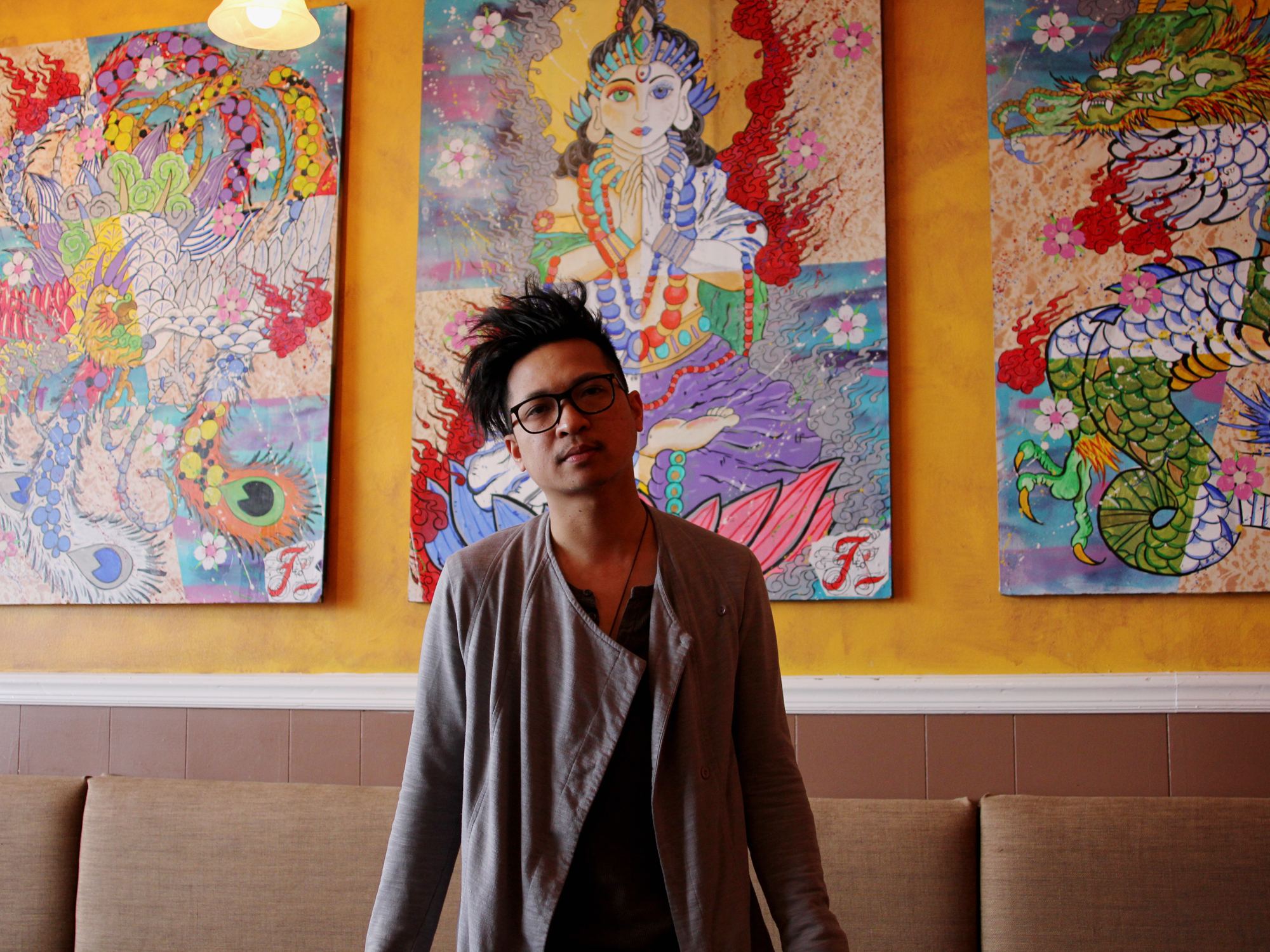“PORK IS REALLY AT THE CENTER of both Filipino and Cuban food,” Raquel Quadreny says, and really, what more do you need to say to understand why there’s a Filipino-Cuban crossover restaurant? With a shared heritage of Spanish and American colonialism and pork, there could hardly be a better matchup of two cultures half a world apart.
The other reason that Bayan Ko, named for a Filpino patriotic anthem (it means “My Country”), is a Filipino-Cuban crossover is because Quadreny is first generation Spanish-Cuban-American, born in Miami of a mother from Cuba and a father from Barcelona. While her fiance and co-owner, chef Lawrence Letrero, is first generation Filipino-American. And in fact, as I come in to the restaurant talk to them, Quadreny has a bunch of picture frames spread out on a table, and is matching them up with black and white photos of each of their parents and grandparents. It’s not obvious at a glance which belongs to which; Quadreny’s grandparents looking out the back of a vintage sedan in Battista’s Cuba (on their wedding night, as it happens) look like spiritual cousins to Letrero’s parents at a dance in Marcos’ Philippines.
Their aim in the restaurant, which opened last weekend in Ravenswood, is to offer a modernized take on their respective cuisines—without doing anything that would shock the grandmas looking down from the wall. “We want to be true to the traditions of our abuelas and our lolas,” Letrero says. “I use a lot of recipes that my grandma passed down to my mom and my mom passed down to me, and the same thing for Raquel. We want to put our spin on it and, I guess, elevate it a little. But those flavors—I think even traditional Cubans and Filipinos will come and they’ll be satisfied.”
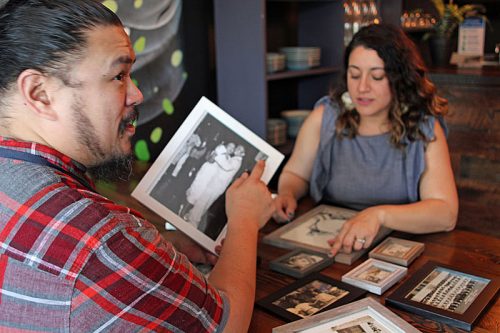
Lawrence Letrero, with a picture of his parents, and Raquel Quadreny
In some cases it means changing the form while retaining the flavor profile. An example is the Cuban dish gambas al ajillo—typically small shrimp stewed in a garlicky sauce. They take big shrimp and grill them, Raquel says, “so they’re a little smoky and juicier, and the sauce is a little fresher,” added after they’re grilled. “We had a lot of stews on the menu, so we wanted something a little lighter. Both of our cuisines are similar in that they have a lot of braises and stews.”
Still, if the form is different, it’s basically built the same way. Raquel says, “This dish has a traditional Cuban sofrito, which is basically slow-cooked-down onions, garlic and various peppers.”
“When we first started dating, when we cooked together, I noticed everything started with sofrito,” Letrero says.
“Pretty much,” Raquel admits. “Every main dish starts with onions, garlic and peppers. It’s a Cuban mirepoix, a more delicious mirepoix.”
Sometimes the overlap between the two cuisines takes something from both. “Our lechon is pork belly, and it has the crispy skin, which is Filipino,” Quadreny explains. “But we marinate it in a Cuban mojo sauce, for 24 hours or more.”
“And we crisp it up when we pick it up, and add more mojo,” Letrero continues. “And the skin stays nice and crispy, and that’s finished with our house achara pickles,” light Asian pickled papaya salad, “and it’s beautiful with a side of rice.”
Crispy is important in Filipino cuisine—texture is a big part of eating. “When you cook a whole pig, Filipinos will go first thing for the ears, and the feet, stuff like that,” Letrero says. “So there’s always got to be some crunch. I don’t cook it all the way until it’s fall-apart.”
“And that’s where the Cubans differ on lechon,” Quadreny says. “They also use pork shoulder, and it’s not as crispy. But I love it, I wanted to take that crispiness and give it the mojo flavor. We have lots of vegetable and gluten-free dishes, too. But we both come from very pork-centric cultures,” she laughs.
Gallery: Filipino Meets Cuban at Bayan Ko
LAWRENCE LETRERO IS ONE OF THOSE PEOPLE whose name I had typed a number of times, going back to Grub Street days, but I had never actually met him. (Although now that I think about it, I’m pretty sure I bought food from him at one of Filipino Kitchen’s Kultura Festivals.) Born in Windsor, Ontario, he started in sales, then applied to Kendall College in Chicago “to get out of Canada and do something different.”
He was smitten with Chicago: “I said, I’m not going anywhere, this city is crazy, it’s amazing. But it’s not like New York—I staged in New York and I thought, I can’t live here. To me, Chicago is a big city, but it has small pockets, and I loved it.” He worked at restaurants from Perennial to Untitled to Sable to the Waldorf-Astoria Hotel—always cooking some version of modern American cuisine, rarely his own traditional food.
“I snuck it on a few menus,” he says. “Catering at the Waldorf—I did lumpia, little bites like that. I’m always trying to get those flavors, citrus and vinegar, into things. Sable was the one where they were most okay with it. I did pork belly adobo there, luglug noodles—that’s pancit palabak, rice noodles with a mix of seafood. We’re going to do it with uni and scallops. It usually has a hard boiled egg, but we’re going to do it with a fresh farm egg.” It’s a dish that has worked for him in other ways—he won with it on a Food Network show called Cooks Vs. Cons.
The lechon is a good example of the kind of fusion that we do—things that make sense. We’re not going to put ropa vieja in a lumpia.
“When I left the Waldorf, I thought, okay, do I keep working for someone else, or do I go for it?” he says. “So we found this little spot in Ravenswood. The neighborhood’s so nice—people walk by every five minutes and say oh, what’s this? We’re having fun.” As if to prove the point, while we’re talking someone comes up and snaps a photo of the restaurants not-yet-open exterior. “So many people have done that. I don’t get what it’s for.”
“Maybe they’re going to look it up when they get home,” Quadreny says. As for her, “I always really wanted to open one of those little cafes where you walk up and order your cafecito. We were looking for a space where we could do that, but this is what happened.” As that day’s craft project with the family photos suggests, she’s taken the lead on the simple but attractive design of the small space, including recruiting their friend Won Kim (chef of Kimski and also a busy street artist) to paint one wall (the one they’re posing in front of in the main photo).
Quadreny originally came to Chicago to study theater at Roosevelt University—”I’d never seen snow before I came here, my family was like, you’ll be back, let’s see how long you last in college up there.” She worked in restaurants as a side job in college, and kept doing so after college, at places from Ronero to Coast Sushi; her last gig was helping open the Wrigleyville Big Star. “I’ve always loved food and I’ve always loved cooking, so it just became natural to me to continue doing this.”
They have a 2-1/2 year-old daughter, and now a restaurant. “A lot of restaurants don’t really cater to kids, and we get that,” Quadreny says. “But we want it to be fun, and to cater to families. We’re just excited to have families in.”

SO THEY’RE AIMING TO TAKE FILIPINO AND CUBAN flavors and make them more accessible and a little playful, for a diverse neighborhood. I mention that some Filipinos in the food industry resent the notion of their national cuisine being called “the next hot Asian cuisine” in America—like Ray Espiritu at Isla Pilipina, who I wrote about here. Turns out they’re frequent customers of the place.
“Going to Isla Pilipina, we find it very traditional, you can taste it,” Letrero says. “It’s a family style restaurant with family style portions—that’s the kind of the way Filipinos cook their food. They’re big platters, you expect to come away with as much food as you eat there. For us it’s going to be smaller plates, something a little more refined, but still give you those flavors that you find at Grandma’s house.”
“I’ve always wanted to do Filipino food, but I don’t know if it would have worked five or six years ago,” he says. “Anthony Bourdain went to the Philippines and made sisig popular. We went to Pig & Khao in New York,” and saw a modernized version of Filipino cuisine there.
“We wanted to add a little more Filipino cuisine to Chicago, and to the United States in general, because there’s not that much. Bring more of a chef-driven, nighttime vibe to it,” Quadreny says.
“It’s literally just food that I enjoy, that I grew up eating,” Letrero says.
“A lot of the menu, we’ve been doing so many parties since we’ve been together,” Quadreny says. “We like to throw family parties, and it’s always a beautiful mix of Cuban flavors and Filipino flavors, and we just really wanted to bring that together. There’s so many similarities—so many stews, so many braises.”
“Chefs hate the word fusion,” Letrero says. “But the lechon is a good example of the kind of fusion that we do—things that make sense. We’re not going to put ropa vieja in a lumpia. When we first started dating, I was saying, I wanted a Filipino restaurant, but when I saw the Cuban food, I saw that this could really work. And we wanted to have a lot of variety on the menu. People say, man, you’re doing a lot of stuff, but that’s the way we eat. You don’t come to a Filipino restaurant and get, like, a dish.”
“We don’t want to be a coursed-out meal. Everything kind of goes together. You eat your lumpia with your lechon and your rice. I mean, you can do whatever you want—we want you to be comfortable,” Quadreny says.
We’re winding up, and though I’ve tasted all of the dishes I’ve photographed, they insist I take them home (oh sure, bend my arm) and start wrapping them up for me. Letrero says, “We’re restaurant people, we love it. Every day you learn something, it’s humbling but then it’s gratifying. I treat every project like it’s my own, you’re working 60, 70 hours for someone else, so why not finally do it on my own?
“We’re a 30-seat restaurant, I get it. But every detail, we’re putting our heart and soul into it.” Like abuelas and lolas always do in the kitchen.
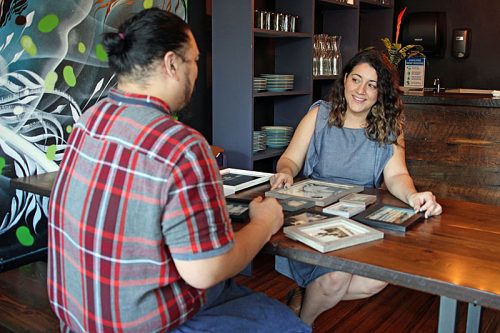
Michael Gebert eats many homelands as editor of Fooditor.
Latest
Join the Discussion
After you comment, click Post. If you're not already logged in you will be asked to log in or register with Disqus.











